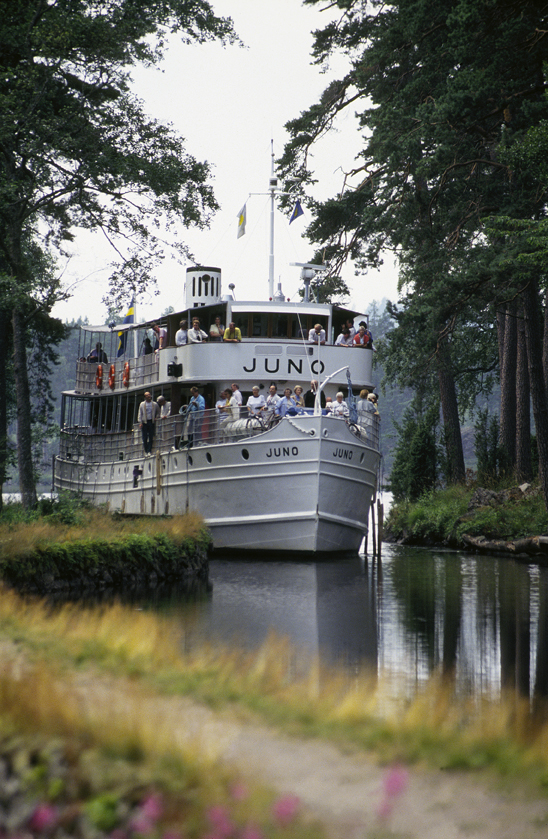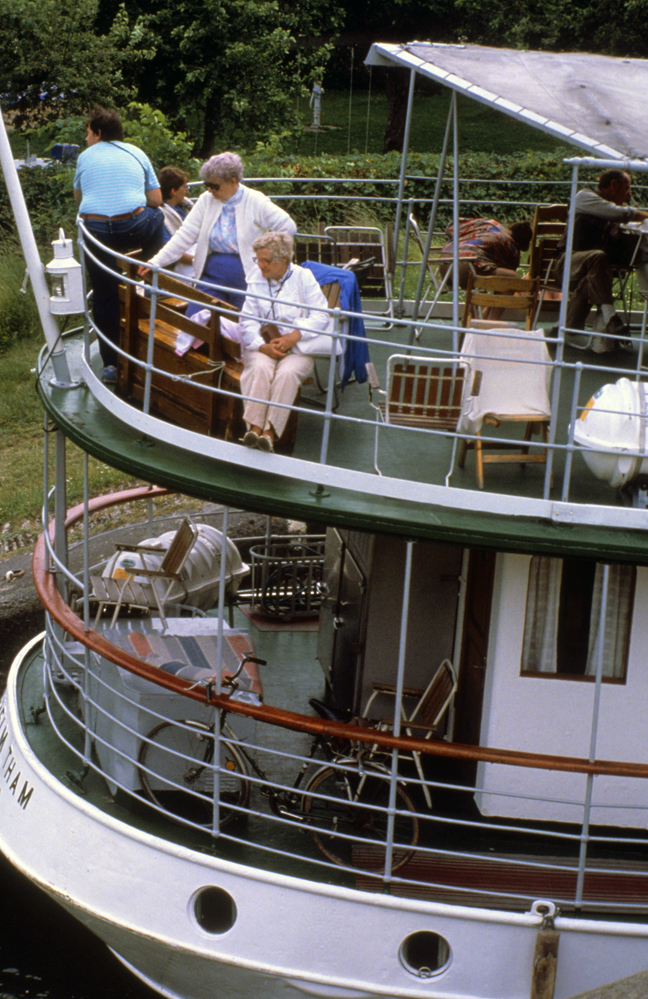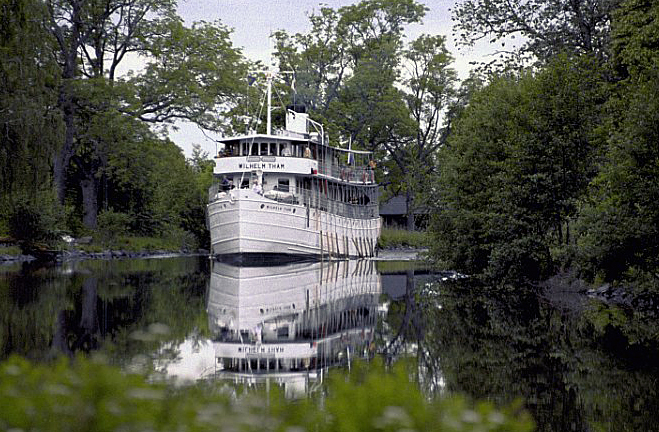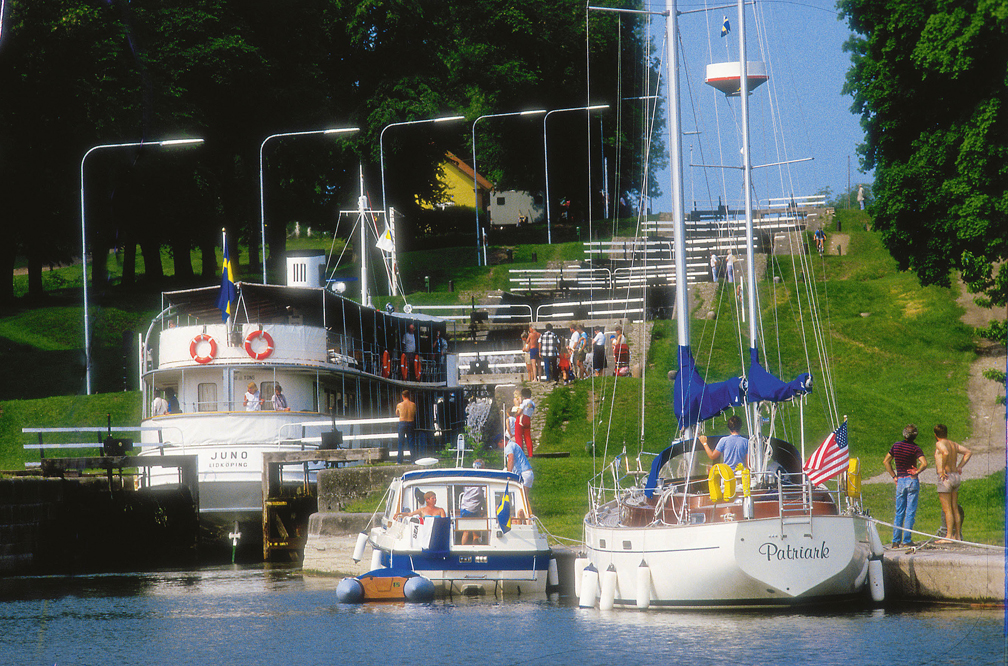Meandering The 'Gota Kanal'
The Gota Canal, or The Blue Ribbon as it is often called, takes its voyagers past castles, monasteries, palaces, medieval churches, and a number of picturesque towns.
-
 The M/S Juno, built in 1874 and rebuilt in 1904, is the oldest and most charming of the three boats on the Göta Canal Line. Photographs courtesy Rederi AB Göta Kanal; http://gotacanal.se
The M/S Juno, built in 1874 and rebuilt in 1904, is the oldest and most charming of the three boats on the Göta Canal Line. Photographs courtesy Rederi AB Göta Kanal; http://gotacanal.se -
-
When Hans Christian Andersen left Copenhagen for a visit to Sweden in 1837, his mind was set on two things: traveling on the Göta Kanal and meeting with Fredrika Bremer, a Swedish writer for whom he had great admiration.
-
 The locks at Berg just outside of Linköping
The locks at Berg just outside of Linköping -
-
That the then obscure writer of fairy tales should be interested in Göta Canal is not surprising. It was the ultimate engineering feat of the day - a system of canals and locks connecting rivers and lakes all the way from Gothenburg in the west to Stockholm in the east, covering 372 miles, and uniting the North Sea with the Baltic. To make it a continuous waterway, sixty miles of rock and soil had had to be cleared away. It featured fifty-eight locks and thirty-five bridges.
Meant to be an important trade route, the Göta Canal was quickly made obsolete by the railroads. In consequence, it has remained largely unchanged, making travel on it something of a 19th-century experience or, as most will say, similar in ambience to travel with the Orient Express. Many of the hand-operated locks are still in use and the pace has not quickened. As in Andersen’s day, traversing the country in one of the three passenger boats run by the Göta Canal Steamship Company takes four days. -
 The ‘Swedish Orient Express on water’ - guests are comfortably seated to enjoy the scenery while others are off on excursions or on a leisurely walk along the canal.
The ‘Swedish Orient Express on water’ - guests are comfortably seated to enjoy the scenery while others are off on excursions or on a leisurely walk along the canal. -
A few years ago, my wife and I took one of these boats, the 138-year old Juno, from Stockholm to Gothenburg. A thoroughly enjoyable event, I thought I would reacquaint myself with the Göta Canal this year, meeting up with the boats in strategic places and catch up with some of the sightseeing, which is part and parcel of these cross country cruises.
My first opportunity came early one day in the village of Berg, where a famous series of locks, eleven in all, link Lake Roxen with the canal. That morning, Wilhelm Tham (at 100 this year, a mere youngster compared to Juno) was due to arrive from the lake and begin a climb that would last for several hours.
This, I knew from previous experience, would give me the chance to board the vessel and chat, perhaps, with those passengers who were not off sightseeing - the particular point of interest her being the Vreta Convent Abbey, a meticulously kept 12th-century nunnery.
Sighting the Wilhem Tham in the morning mist brought back strong memories. After Stockholm and some fifty miles of Baltic archipelago, this, I recalled, was where the canal truly takes over and begins to exert its special magic. From this point on came the sensation of gliding silently through the heart of the Swedish countryside, first as you approached Lake Vättern, then as the canal resumed it meandering ways, to the next large body of water, Lake Vänern, for miles, where the canal was just wide enough for the boat, the water would seem to disappear, leaving you floating alternatively through dense woods - where you could reach out and almost touch the tree branches - and quilts of open fields, punctuated by grazing cattle and, typically, red or yellow farmhouses.
Now, as the Wilhem Tham pause between two locks, I jumped aboard. How familiar it all felt: The same youthful, attentive yet relaxed crew, the same spirit of everyone being one big family. Of course, a good portion of that family was now on its way to the nunnery. I ducked into the empty dining room, curious about the day’s menu. “Poached Salmon,” and - how very Swedish and yet with an American twist - “Burger of Elkmeat and Lingonberries, with Blackcurrant Jam and Glazed sugar Peas,” Back on deck I noticed that practically all the passengers were gone, leaving me little opportunity for chats. Ah, there was a familiar sight! The captain’s bicycle, tied to the railing at the stern, looking old and just like the one I borrowed years ago.
Then, with my tripod strapped to the basket, I had followed one of the towpaths, soon outdistancing the Juno, when the slow-moving vessel caught up with me, shining white from behind verdant foliage; I was all set with a fresh roll of film. These towpaths, incidentally, have traffic of their own. Once used by oxen for hauling barges and sailing craft, they now bustle with cyclists and hikers. -
 M/S Wilhelm Tham going through a narrow bend in the canal.
M/S Wilhelm Tham going through a narrow bend in the canal. -
The Göta Canal, or The Blue Ribbon as it is often called, takes its voyagers past castles, monasteries, palaces, medieval churches, and a number of picturesque towns. One such town is Vadstena. Idyllically situated on the eastern shore of Lake Vättern, and once an important center for pilgrims, Vadstena evolved around a cluster of 14th-century religious buildings. It has narrow, twisting streets with old, beautifully preserved wooden houses.
As I approached its rather spectacular harbor, featuring a Renaissance castle with a medieval-looking moat, I sighted an old friend - the Juno.
It proved to have been chartered by a group of Americans who, now saturated with sightseeing, were coming back for dinner. Asked how they felt about the Göta Canal, each one agreed that this was a great way to really see the country. Referring to her recent encounter with Vadstena, one woman exuberantly exclaimed: “It was wonderful! In three hours we saw all the sights, including two weddings and a confirmation ceremony.”
By the way, when Hans Christian Andersen asked for the whereabouts of Fredrika Bremer, he was told that she was in Norway. This didn’t discourage the young Dane. “Whenever I travel,” he said, “luck is with me. I’m sure I’ll meet her.” The next morning he left his cabin at dawn to watch the sunrise over Lake Vänern, expecting to have the deck to himself. Instead he ran into a lady wrapped in a coat and shawl - a new passenger who also wanted to see the sun go up.
It was, of course, Fredrika Bremer.
Written by Bo Zaunders
Photographs courtesy of Göta Kanal -
 The ‘Swedish Orient Express on water’ Göta Canal’s Juno at the locks at Berg just outside of Linköping, between Lake Vättern and the Baltic
The ‘Swedish Orient Express on water’ Göta Canal’s Juno at the locks at Berg just outside of Linköping, between Lake Vättern and the Baltic -
Incidental Intelligence
The trip for Hans Christian Andersen from Copenhagen to his starting point may have taken him just under a day—best case scenario! These days, you fly to Scandinavia in around 7 hours from the U.S. east coast. Check Scandinavian Airlines online, www.flysas.com, or at SAS on facebook for the best available travel deals to get to Rederi Ab Göta Kanal right now or towards next summer. -
When to go: The Göta Canal Steamship Company operates mid-May to mid-September. June, with its long days and midsummer festivities, is the most magical time to visit, though the boats tend to be more crowded at that time. July is when the Swedes themselves take their summer vacations.
-
The boats: There are three boats on the Göta Canal Line: M/S Juno, M/S Wilhelm Tham, and M/S Diana. The Juno, built in 1874 and rebuilt in 1904, is the oldest and most charming, but its cabins are also the smallest. Of the three, Diana, from the 1930’s, is the youngest and most comfortable. Wilhelm Tham (1912) falls between the two, both in age and comfort. As for the cabins, they’re generally small. On the Juno, the two best cabins are on shelter deck, behind the dining room, but the cabins on the bridge deck are also quite acceptable.
-
Prices: Prices are comparable to those on a luxury ocean liner but cabins in general much smaller than you’re used to and service and all other aspects of the accommodations, well, having more in common with the Orient Express on water than anything you’ve ever experienced before. For two passengers in a double cabin, depending on cabin, the two-day mini canal cruise will run $1,500 - $2,500, the classic four day cruise $3,400 - $6,200 and the luxury Great Swedish 6-day cruise $5,000 - $8,000 (prices are for two). These prices were converted from Swedish kronor and do not take into account early booking discounts and are based on the exchange rate in early November 2012.
-
Contacts: The simplest way to find out more about how to meander the Göta Canal, is to visit the general information site http://gotacanal.se or www.stromma.se/en/Gota-Kanal for the actual Rederi AB Göta Kanal we covered here. To speak directly to a representative of the Göta Canal Company in Sweden, call int. +46-(0)31-80 63 15. Or, go online, head for stromma.se/en/Gota-Kanal.
-
-
